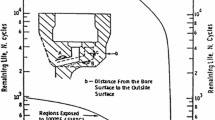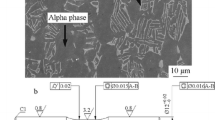Abstract
Increasingly accurate life prediction models are required to utilize the full capability of current and future advanced materials in gas turbine engines. Of particular recent interest are predictions of the lifetimes of engine airfoil materials that experience significant intervals of high-frequency, high-cycle fatigue (HCF). Conventional life management practices for HCF in the turbine engine industry have been based principally on a total-life approach. There is a growing need to develop damage tolerance methods capable of predicting the evolution and growth of HCF damage in the presence of foreign object damage (FOD), low cycle fatigue (LCF), and surface fretting fatigue.
To help identify key aspects of the HCF life prediction problem for turbine engine components, a review is pressented of the extensive results of an Air Force research contract with Pratt & Whitney on the high strength titanium alloy Ti-8Al-1Mo-1V. Data from this representative turbine-airfoil material are used to examine the applicability of linear elastic fracture mechanics methods for prediction of service lifetimes under load spectra that include high cycle fatigue. The roles of fatigue crack initiation and growth are examined for materials that are nominally-defect-free, as well for materials that have experienced significant prior structural damage. An assessment is presented of the potential utility of the conventional threshold stress intensity factor range, ΔK th, defined by testing specimens containing large cracks. Although the general utility of a large-crack-ΔK th approach is questionable due to the potentially rapid growth of small fatigue cracks, the low allowable stresses involved in turbine engine high cycle fatigue appear to limit and simplify the small-crack problem. An examination is also presented of the potential effects of high-cycle fatigue and low-cycle fatigue (HCF/LCF) interactions.
Similar content being viewed by others
References
U.S. Air Force, Engine Structural Integrity Program, Military Standard 1783, Aeronautical Systems Division, Wright-Patterson Air Force Base, OH, 1984.
T. Nicholas and J.R. Zuiker, On the use of the Goodman diagram for high cycle fatigue design, International Journal of Fracture 80 (1996) 219–235.
B.A. Cowles, High cycle fatigue in aircraft gas turbines — an industry perspective, International Journal of Fracture 80 (1996) 147–163.
G.E. Dieter, Mechanical Metallurgy, Second Edition, McGraw Hill, New York (1976) 435–438.
F.K. Haake, G.C. Salivar, J.W. Fishcher and C.G. AnnisJr., Threshold Fatigue Crack Growth Behavior, U.S. Air Force Technical Report WRDC-TR-89–4085, Wright-Patterson Air Force Base, OH, 1989.
T. Nicholas, J.P. Barber and R.S. Bertke, Impact Damage on Titanium Leading Edges from Small Hard Objects, U.S. Air Force Technical Report AFML-TR-78–173, Wright-Patterson Air Force Base, OH, 1978.
T. Nicholas, J.P. Barber and R.S. Bertke, Impact Damage on Titanium Leading Edges from Small Hard Objects, Experimental Mechanics 20: 10 (1980) 357–364.
G.C. Salivar, J.E. Heine and F.K. Haake, The Effect of Stress Ratio on the Near-Threshold Fatigue Crack Growth Behavior of Ti-8A1–1Mo-1V at Elevated Temperature, Engineering Fracture Mechanics 32: 5 (1989) 807–817.
G.C. Salivar and F.K. Haake, A Comparison of Test Methods for the Determination of Fatigue Crack Growth Rate Threshold in Titanium at Elevated Temperature, Engineering Fracture Mechanics 37: 3 (1990) 505–517.
E.W. Collings, Physical Metallurgy of Titanium Alloys, ASM International, Metals Park, OH, (1984).
Standard Test Method for Measurement of Fatigue Crack Growth Rates, ASTM E647–86a, Annual Book of Standards, Vol.3.01 (1987) 899–926.
H. Doker, V. Bachmann and G. Marci, A Comparison of Different Methods of Determination of the Threshold for Fatigue Crack Propagation, International Symposium of Fatigue Thresholds, Stockholm, EMAS (1981) 48.1–48.17.
W.A. Herman, R.W. Hertzberg and R. Jaccard, A Simplified Laboratory Approach for the Prediction of Short Crack Behavior in Engineering Structures, Fatigue and Fracture of Engineering Materials and Structures, 11 (1988) 303–320.
Mechanics of Fatigue Crack Closure, ASTM STP 982, J.C. Newman, Jr. and W. Elber (eds.), Philadelphia (1988).
I.A. Raju and J.C. Newman, Jr., Stress-Intensity Factors for Circumferential Surface Cracks in Pipes and Rods Under Tension and Bending Loads, in Fracture Mechanics: Seventeenth Volume, ASTM STP 905, J.H. Underwood, R. Chait, C.W. Smith, W.P. Wilhelm, W.A. Andrews and J.C. Newman (eds.), Philadelphia (1986) 789–805.
J.C. Newman, Jr. and I.S. Raju, Stress-Intensity Factor Equations for Cracks in Three-Dimensional Finite Bodies, in Fracture Mechanics: Fourteenth Symposium-Volume I: Theory and Analysis, ASTM STP 791, J.C. Lewis and G. Sines (eds.), Philadelphia, PA (1983) I-238-I-265.
R.E. Peterson, Stress Concentration Factors, First Edition, John Wiley & Sons, New York (1976) 20–36.
J.R. Zuiker and T. Nicholas, Observations and Limitations of the Use of the Goodman Diagram for Combined HCF/LCF Loading, Fatigue' 96, Elsevier Science Ltd., Oxford, U.K. (1996) 467–472.
J.R. Zuiker and T. Nicholas, On High Cycle Fatigue Design Limits Under Combined High and Low Cycle Fatigue, International Journal of Fatigue, in press.
S. Suresh and R.O. Ritchie, Propagation of Short Fatigue Cracks, International Metals Reviews 29 (1984) 445–476.
Small Fatigue Cracks, R.O. Ritchie and J. Lankford (eds.), The Minerals, Metals, and Materials Society, Warrendale, PA (1986).
The Behaviour of Short Fatigue Cracks, EGF Pub. 1, K.J. Miller and E.R.de los Rios (eds.), Mechanical Engineering Publications, London (1986).
K.J. Miller and E.R.de los Rios, Short Fatigue Cracks, Mechanical Engineering Publications Limited, London (1992).
M.S. Miller and J.P. Gallagher, An Analysis of Several Fatigue Crack Growth Rate (FCGR) Descriptions, in Fatigue Crack Growth Measurement and Data Analysis, ASTM STP 738, Philadelphia, PA (1981) 205–251.
J.M. Larsen, B.D. Worth, S.J. Balsone and J.W. Jones, An Overview of the Structural Capability of Available Gamma Titanium Aluminide Alloys, Gamma Titanium Aluminides, Y-W. Kim, R. Wagner, and M. Yamaguchi (eds.) TMS/ASM International, Warrendale, PA (1985) 821–834.
D.L. Davidson and J. Lankford, Fatigue Crack Growth in Metals and Alloys: Mechanisms and Micromechanics, International Materials Reviews 37: 2 (1992) 45–76.
J.C. Newman, Jr., Fracture Mechanics Parameters for Small Fatigue Cracks, in Small-Crack Test Methods, ASTM STP 1149, J.M. Larsen and J.E. Allison (eds.), Philadelphia, PA (1992) 6–33.
Author information
Authors and Affiliations
Rights and permissions
About this article
Cite this article
Larsen, J.M., Worth, B.D., Annis, C.G. et al. An assessment of the role of near-threshold crack growth in high-cycle-fatigue life prediction of aerospace titanium alloys under turbine engine spectra. Int J Fract 80, 237–255 (1996). https://doi.org/10.1007/BF00012671
Received:
Accepted:
Published:
Issue Date:
DOI: https://doi.org/10.1007/BF00012671




